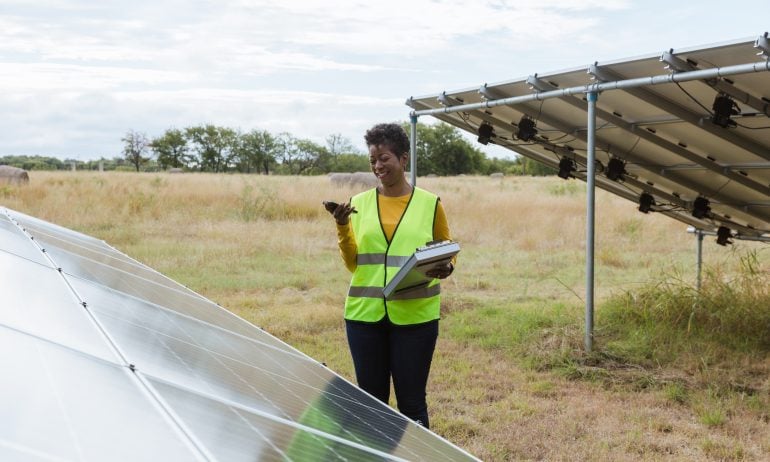Ground-Mounted Solar Panels: What to Know

Some or all of the mortgage lenders featured on our site are advertising partners of NerdWallet, but this does not influence our evaluations, lender star ratings or the order in which lenders are listed on the page. Our opinions are our own. Here is a list of our partners.
Ground-mounted solar panels are solar panels installed on the ground instead of on a roof. The average cost is $53,800 (before tax incentives), or about 10% to 15% more than roof-mounted panels. Ground-mounted solar panels are a way to go solar if a house's roof isn’t suited for it.
» MORE: Best solar companies of 2024
Understanding ground-mounted solar panels
Ground-mounted solar panels are very similar to roof-mounted solar panels; the difference is where and how they’re mounted. In either case, the photovoltaic cells in the panels absorb photons of sunlight and convert them to DC electricity. The system’s inverter then converts the direct current (DC) energy into usable alternating current (AC) electricity that’s compatible with the grid.
There are two ways to install ground-mounted solar panels:
Standard ground mount: This is the easiest and most affordable way to install solar panels on the ground. The solar panels are attached to a metal frame using small anchors, much like roof-mounted solar panels are set up. Then, the frame is tilted to the angle that catches the most sunlight. This mounting style typically remains in a fixed position, although manually adjustable options are becoming available.
Pole mount: This uses a pole planted in the ground in a concrete foundation. Pole mounts can be either top-of-the-pole (which generally uses single- or dual-axis solar tracking to follow the sun’s rays) or side-of-the-pole (which usually cannot use solar tracking). Side-of-the-pole mounts are suited to smaller solar systems and usually hold one, two or three panels. Pole mounting has the advantage of keeping the panels farther off the ground, which can keep them clear of foliage and other obstructions.
» MORE: Do solar panels work at night?
Who are ground-mounted solar panels best for?
Homeowners choose ground-mounted solar for several reasons, including:
High energy needs: The home uses more energy than roof-mounted solar panels can provide.
Suboptimum roof orientation, location or pitch: A roof that faces north, west or east may not receive enough sunlight to meet the home’s needs. Additionally, a roof that’s in shade for most of the day or isn’t the right pitch to catch sunlight isn’t a good fit for roof-mounted panels.
Poor roof condition: An aging roof that needs replacement may not be able to bear the weight of the panels or survive the installation. Plus, the solar panels may need to be removed to replace the roof.
Concern about damaging the roof: Homeowners who don’t want to risk damaging their roofs during solar installation may prefer to mount solar panels on the ground.
Maintenance concerns: It’s easier to access, clean and monitor ground-mounted solar panels than those mounted on a roof.
» MORE: Pros and cons of going solar
Ground-mounted solar costs
The average cost of a ground-mounted solar system before tax incentives is $53,800 (before tax incentives) and is about 10% to 15% more than roof-mounted panels. This is in part because roof mounting uses an existing structure (the roof), while ground-mounting requires cement foundations and/or poles, which increases the costs of materials and installation labor. Whether your particular ground-mounted system is at the high or low end of this range depends on the size and complexity of the system, materials, permits and connection fees, as well as the mounting type.
» MORE: Compare solar loan options
Space requirements for ground-mounted solar panels
You’ll need to sacrifice some of your yard to accommodate a ground-mounted solar array. Solar panel sizes vary by brand, but generally, about 350-450 square feet of land is needed for 15 to 25 panels.
Advantages of ground-mounted solar panels
Opting for ground mounting brings many benefits including:
Greater potential efficiency: Because ground mounting is a way to avoid shade, position panels optimally or install tracking capabilities so the panels follow the sun, you may be able to generate more electricity than with roof-mounted panels. Additionally, ground mounting leaves more space between the panels and their bases. This creates better airflow and helps keep panels cooler and more efficient.
No worries about roof damage: Improper installation could damage your roof and lead to water leaks. This isn’t an issue when panels are mounted on the ground. Additionally, there’s no need to move the panels if you need the roof replaced.
Easier, safer maintenance: You don’t have to get up on the roof to clean, troubleshoot, inspect and repair your panels.
Room to expand: The system isn’t limited by the size of your roof, so you can add additional panels if energy needs increase over time.
Disadvantages of ground-mounted solar panels
There are also some drawbacks to ground-mounted solar panels to be aware of:
Higher upfront cost: Because of the additional materials and labor required for installation, ground-mounted solar generally costs about 10% to 15% more to install than roof-mounted panels, according to one provider. (Better efficiency due to optimum positioning of panels and improved airflow may offset that cost, however.)
Loss of yard space: Mounting panels on the ground typically means giving up at least 350 square feet of usable yard space.
More vulnerable to damage and vandalism: Ground positioning leaves panels more accessible to rocks and debris thrown from garden equipment, as well as to wildlife, thieves and vandals.
More challenging permitting process: Because they involve freestanding structures, the permitting process for ground-mounted solar arrays may be complex and time-consuming.
Aesthetic issues: Ground-mounted solar takes up yard space and is more visible. Some consider these arrays an eyesore.


